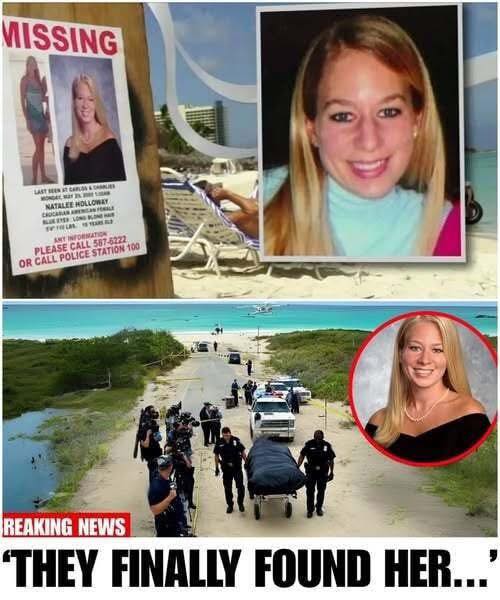Natalee Holloway’s story began as a celebration — a high school graduation trip full of excitement, sun, and freedom. In May 2005, the 18-year-old from Alabama traveled to Aruba with her classmates for one last adventure before heading off to college. She was bright, ambitious, and ready to step into adulthood. But what was supposed to be a carefree trip became one of the most haunting disappearances in modern history.
On the night of May 30, Natalee was last seen leaving a popular nightclub in the company of a young Dutch man named Joran van der Sloot. Several classmates watched her get into a car with him and two of his friends. That was the final confirmed moment anyone saw her alive. When she didn’t show up for the flight home the next morning, an immediate alarm went off. Her luggage was still neatly packed in her room. Her passport was untouched. There was no sign she had planned to go anywhere. She was simply gone.Aruban authorities launched a massive search — beaches combed, waters scanned, abandoned sites dug through, tourists questioned, locals interrogated, and countless tips investigated. The island had never seen anything like it. Volunteers worked shoulder-to-shoulder with officials, driven by the desperate hope that Natalee was still alive. But despite the scale of the search, no trace of her was ever found.
Public suspicion centered almost instantly on Joran van der Sloot, the last person seen with her. His story changed repeatedly, creating more questions than answers. At first, he claimed he dropped her at her hotel. Later, he said he left her on the beach. His contradictions pulled the investigation in circles and only deepened the mystery.
For years, the case dominated headlines and true-crime discussions around the world. Every development — real or rumored — was dissected. Every new interview with investigators or witnesses reignited interest. And every false lead broke her family’s heart a little more. In 2012, Natalee was finally declared legally dead, not because the family had given up, but because they had been forced to accept a grim reality: whatever happened that night, she was not coming home.The story didn’t end with the search. In 2010, a disturbing twist emerged. Van der Sloot contacted Natalee’s mother, Beth Holloway, claiming he knew where her daughter’s remains were. He demanded money in exchange for the information. Desperate for answers, Beth agreed. But the supposed location he gave was a lie. His attempt to exploit a grieving mother led to U.S. federal extortion charges. It exposed him further as a manipulator, someone who used tragedy as a bargaining chip.
Then, in 2023, nearly two decades after Natalee vanished, the truth finally cracked open. As part of a plea deal in the U.S. extortion case, van der Sloot admitted he was responsible for Natalee’s death. His confession described the moment she died and how he disposed of her body. It was brutal, and it was irreversible. Yet it also brought the first concrete answers her family had heard in eighteen years.
But even with a confession, justice remained complicated. Under Aruban law, the statute of limitations for homicide is twelve years. By the time he confessed, that window had long closed. The island could no longer prosecute him for Natalee’s death. Instead, van der Sloot remains imprisoned on other charges — including a murder conviction in Peru and the extortion case in the United States. He is serving time, but not for the crime that shattered Natalee’s family.For Beth Holloway, the confession was both a final blow and a final release. For nearly two decades, she had lived between hope and torment, fighting to keep her daughter’s story alive as the world speculated, judged, theorized, and obsessed. When van der Sloot finally admitted the truth, Beth said the words she had waited too long to speak: “As far as I’m concerned, it’s over. Joran van der Sloot is the killer.”
Her statement wasn’t softness or forgiveness. It was acceptance — the kind that comes when there is nothing left to fight for except peace. It marked an end to a nightmare that stole years from her life and turned a family tragedy into a global media storm.
Natalee’s disappearance changed more than one family. It changed how people think about travel safety. It changed how international investigations are handled. It changed how the public engages with missing-person cases. And it exposed the darker realities of a young man capable of violence, manipulation, and deception.
Today, Natalee Holloway is remembered not just as a case, not just as a headline, but as a young woman with dreams that were cut short. She was supposed to start college that fall. She wanted to study medicine. She wanted to make a difference. She wanted to live a life that had barely begun.
Her story remains one of the most heartbreaking and widely known missing-person cases of the century. It stands as a reminder of how quickly life can change, how fragile safety can be, and how relentless a family’s love can become when answers are stolen from them.
The investigation may be closed, the legal battles may be settled, and the confession may have delivered the final piece of truth — but the weight of what happened to Natalee Holloway will never fully fade. The world remembers her because the world was watching, and because her family refused to let her disappear into silence.And in the end, that persistence brought the truth to light, even if it came far too late.


